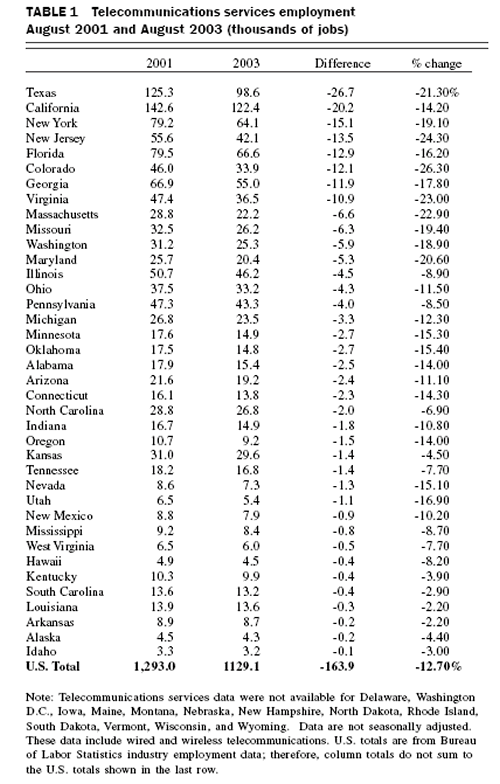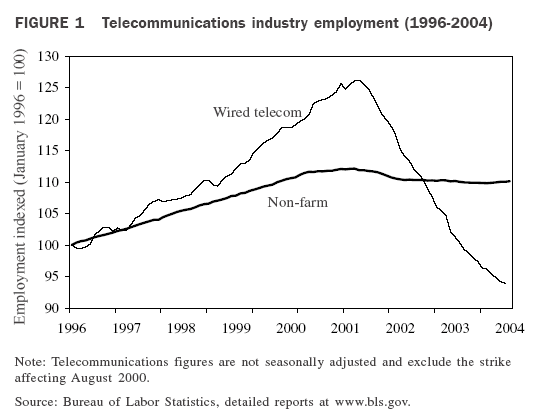 May 2004 | EPI Book
May 2004 | EPI Book
Purchase this book
A Failure to Communicate
Reforming Public Policy in the Telecommunications Industry
by Stephen Pociask
Introduction: Telecommunications and the economy
The telecommunications service industry, consisting primarily of local, long distance, and wireless communications service providers, generated an estimated $241 billion in output in 2003. The telecommunications industry grew faster than the overall economy, expanding 70% (compared to a 60% expansion of gross domestic product) for the 1992 to 2001 period.4 Although the industry’s output represented only 2.2% of GDP in 2003, the telecommunications service industry has been an important catalyst to economic growth and technological innovation in the past century.5 In addition to the direct jobs that telecommunications services provide to workers and the billions of dollars of investment in equipment and infrastructure needed to provide telecommunications services, consumers have come to depend on telecommunications services as a major part of their daily lives, both at work and at home. As a result, while telecommunications service as a percentage of GDP may appear small, the industry’s positive effects on the economy have been immense.
Telecom’s link to economic growth and jobs
As with other high-tech industries, the health of the telecommunications service industry is inextricably linked to the health of the U.S. economy.6 Studies have shown that technological investments, including telecommunications investments, have contributed to more than 30% of the acceleration of GDP growth from the 1990-95 period to the 1995-2000 period.7 Industries that rely on information technology (IT) accounted for nearly all of economy’s productivity growth during that period.8
The telecommunications service industry is an important economic driver for stimulating employment in the overall U.S. economy. For instance, demand for telecommunications equipment manufacturing is largely dependent upon demand for telecommunications services. An increase in the telecommunications demand and its corresponding increase in manufacturing output can have large indirect benefits elsewhere in the economy. For instance, two separate studies estimate that an expansion of telecommunications investments for high-speed telecommunications services would cascade throughout the economy and lead to 1.2 million new jobs.9 Furthermore, if these high-speed services were ubiquitously deployed, one study estimated that the consumer benefits throughout the economy would reach $500 billion.10 In summary, telecommunications investment provides sizable and significant benefit to consumers and the overall economy.
The Telecommunications Act of 1996 and industry growth
Because telecommunications investment can spur macroeconomic growth, create new jobs, and increase consumer benefits, public policies that encourage telecommunications investment can lead to significant and positive economic results. This link between telecommunications investment and economic growth largely explains some of the sentiment behind the passage of the Telecommunications Act of 1996. The Act sought to shape public policy in order to achieve three major goals, as outlined in the passage below:
…to promote competition and reduce regulation in order to secure lower prices and higher quality of services for American telecommunications customers and encourage the rapid deployment of new telecommunications technologies.11
These three goals—lower prices, higher quality, and rapid deployment of technologies—became the cornerstone of public policy regarding telecommunications. The intent was to create a better telecommunications environment that would benefit consumers as well as the economy as a whole.
However, the Act’s promise of consumer and economic advantages has proven elusive. After an initial surge in market entry and an increase in economic growth, investment, and jobs, the telecommunications industry has experienced an unprecedented economic contraction. Telecommunications capital spending by the incumbent local exchange carriers (ILECs)—including descendents of the original regional Bell operating companies—and by newly formed competitive local exchange carriers (CLECs) fell by about 50% from a peak in 2000.12 During the slump, these telecommunications industry providers experienced nearly a $1 trillion increase in corporate debt and a $2 trillion decrease in market value.13 The market value for telecommunications equipment manufacturers alone fell by $1 trillion from March 2000 to March 2001.14
These telecommunications losses were also reflected in the industry’s employment levels, as employment in the telecommunications services industry fell by nearly 193,000 employees from January 2000 to November 2003. As Table 1 shows, the industry lost almost 164,000 jobs between August 2001 and August 2003. Table 1 also indicates that the decline in employment was not isolated to just a few states, but affected every state where data was available. This unprecedented and persistent decline has left the industry in atrophy—exactly the opposite of what the Act intended.

The wired telecommunications sector of the telecommunications industry, consisting of facility-based local and long-distance carriers, employs 54% of all telecommunications workers.15 Wired telecommunications service-sector employment decreased by 142,000 jobs after January 2001, accounting for 74% of the employment decrease in the broader telecommunications industry. For the wired telecommunications industry, this represents an 18% decrease, compared to a 0.6% loss for non-farm employment. Put into perspective, while the wired telecommunications sector represents less than 0.5% of all non-farm employment, the industry accounted for 7% of the decrease in non-farm employment since December 2000. This sharp reduction in employment was in stark contrast to the growth that occurred immediately after the passage of the Act. As Figure 1 shows, after a surge in employment, nearly all of the wired telecommunications jobs created since the passage of the Act are now gone, and employment for the industry now stands at its lowest level since June 1996.

The timing of the contraction in telecommunications and subsequent economic recovery is particularly noteworthy. Historically, the telecommunications services industry has been cyclically resilient, meaning that the industry has not been particularly affected by economic downturns. However, that historical resilience no longer appears to hold true. Most of the job loss in wired telecommunications occurred since the economic recession was officially declared over in November 2001.16
The continued loss of jobs and reduction in investment are compelling examples of how the jobless recovery has affected the broader economy. The decrease in wired telecommunications service industry employment and investment has had ripple effects elsewhere in the economy. For instance, because wired telecommunications service providers have reduced their investments, the employment
levels of firms that manufacture electronic and cable equipment has fallen. In fact, employment for the telephone apparatus manufacturing industry has fallen 56% since December 2000, representing a loss of 57,000 jobs.
While a number of other factors have contributed to the decline in telecommunications employment—most notably, recessionary effects caused by an equity bubble and corporate fraud—misguided regulatory policies may have also played a major role in the collapse of the industry. If public policies that encourage telecommunications investment can spur economic growth, then the reverse is true—namely, public policies that discourage investment can have negative effects on economic growth and consumer benefits.
The next section will discuss telecommunications wholesale policies and how these policies may affect competition and incentives to invest. A later section estimates the effect of these policies on investment and job growth during the recent market collapse.
